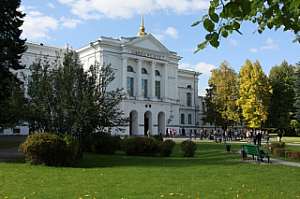Mikhail Zinoviev, a Master’s student led by the head of the laboratory SPhTI TSU Aleksey Zemlyanov, has examined how the characteristics of random lasers change with the addition of aggregated nanoparticles in the active medium. With the help of experiments, scientists have figured out how to reduce the laser generation threshold by a factor of 1,000, which will significantly increase its effectiveness.
In a conventional laser, light moves inside, bouncing off the mirrors, and during the movement of light, it intensifies in the active medium (generation), due to which the beam is formed. The random lasers are those in which the light amplification is achieved without the use of mirrors. The absence of resonators makes the manufacture of random lasers cheaper and technologically simpler. The ability to control the properties of these lasers allows using the unique characteristics of their light in scientific equipment and for industrial and medical purposes.
TSU scientists are studying the random lasers with solutions of organic dyes as the active medium. Their goal is to reduce the laser generation threshold to achieve greater efficiency.
- We added agglomerated nanoparticles of silver, aluminum, gold, and other metals to the liquid organic dyes and also added dielectrics such as titanium oxide and aluminum oxide, - said Mikhail Zinovev. - If you use a pure dye without nanoparticles, the lasing threshold will be high, and the efficiency will be low. That is, you need to spend a lot of energy to achieve a generation, and it is impractical.
Similar studies are being conducted in the US, the EU, China, Iran, and other countries. However, TSU scientists were the first who used in their work not single but aggregated nanoparticles. And also nanoparticles are made not of precious metals, but aluminum, iron, and others. This technology reduces the cost because one gram of gold costs about 2,000 rubles, while one gram of aluminum costs less than 1 ruble.
At the moment, TSU scientists have obtained the most effective lowering of the generation threshold by adding 0.1-1% volume fraction of silver or aluminum nanoparticles. It has allowed reducing the lasing threshold by a factor of 1,000.
- Study of active media with nanoparticles is necessary to create new components for optoelectronics, - says Aleksey Zemlyanov.

